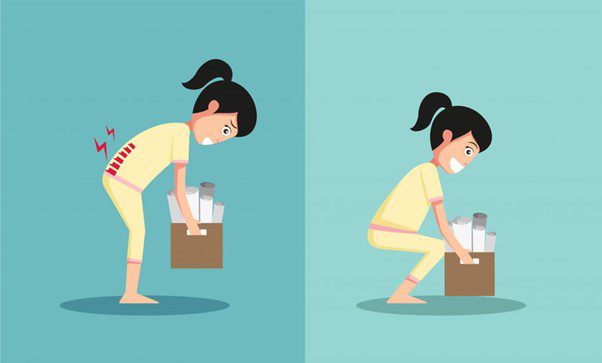
Horror stories abound of people sustaining injuries from attempting to move heavy items incorrectly. In Singapore, a brief survey of local chiropractors reveals that the most common injury area in the back and most lifting injuries are due to a lack of preparation. Here at TheLorry, we quite literally want you to be ‘well-adjusted’. While we recommend you when moving to a new house, there might be times when carrying heavy objects become unavoidable. So here are three ways to safely do so.

The Squatting Lift
- Stand close to the load with the feet shoulders width apart. To increase balance, place one foot slightly in front of the other.
- Squat down, bending at the knees only. Do not bend at the waist.
- Keeping your back straight (but not locked), tuck your chin in.
- Firmly grasp the object with both hands. Make certain your grip is firm and that you are confident of sustaining it before executing the lift.
- Tighten your stomach muscles and lift from your legs. Feel your leg muscles work to execute the lift rather than your upper body.
- When you are standing, keep the weight of the object as close to your body as possible. As a general rule, the further the weight of the object extends from your own body, the greater the impact on your lumbar region.
- Do not at any point in time twist or bend your body. When you turn with the object, turn with your feet and not with your body.
The Knee-On-The- Floor Lift
- Similar to the Squatting Lift, start placing your feet shoulder-width apart.
- Sink on one knee over or as close to your object as possible. Remember to keep your back straight and loose, with your chin tucked in to protect your spine.
- Get a firm hold of the object.
- Tighten your stomach muscles and propel the lift towards you. You might break this move up by resting the object on your knee as you prepare to stand.
- Moving smoothly, use your leg muscles to stand. Keep the weight of the object as close to your body as possible.
- Adjust your back, keeping your core muscles tightly engaged in the lift and maintaining the natural curve of your spine.
- Now you may move.
The Straight Leg Lift
This lifting technique is not recommended unless something is blocking you from getting bodily close to the object, for example when removing items from the boot of a car or the back of a lorry.
- Stand as close to the object as possible, with your knees slightly bent. Never lift anything with a straight leg! Any lift positions however awkward must be executed with your knees partially bent.
- Do not bend your waist. Instead, push your buttocks out to level your body down closer to the object.
- Keeping your elbows tucked close to your body, reach out to grasp the object firmly.
- Tighten your stomach muscles. Straighten your head and look forward to preparing for the lift.
- Lift upwards and toward you. Straighten your back and extend your legs.
- Do not at any point in time twist or bend your body. When you turn with the object, (i.e., away from the car) turn with your feet and not with your body.
Important takeaway
Because you know your own body best, make sure you pick the right lifting method that feels comfortable to you. No matter which stance you adopt for lifting, be sure to do a few minutes of stretching beforehand to warm up and loosen your muscles. Hardworking swots should invest in the time to do some ‘practice lifts’ with large or awkward sized objects (say, an empty box) so that you can observe your body mechanics.
Taking prior note of the paths you’ll take, say a tricky staircase or that moment where you need to remove your shoes – will help you anticipate where you will probably be putting more pressure on your joints.
Above all, take your time and stay safe, because protecting your back is worth all the caution in the world.




 SG
SG Malaysia
Malaysia Indonesia
Indonesia
Recent Comments